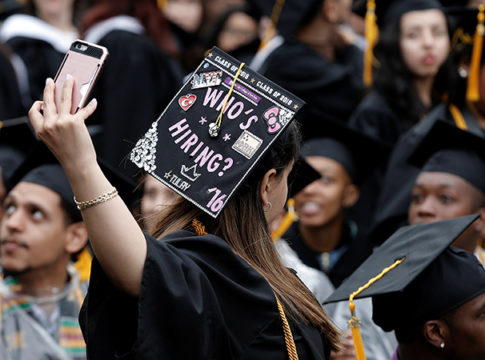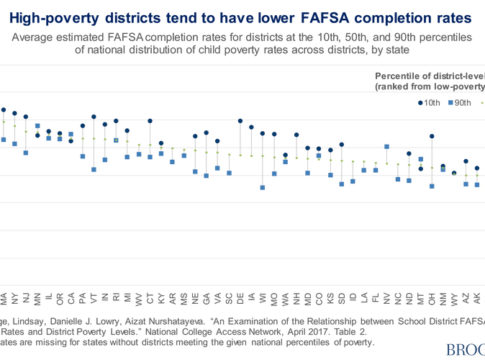
Novel research that focuses on student loans tends to receive considerable attention these days. Yet two recent studies with big implications for the federal student loan program have gone largely unnoticed. Perhaps that is just a coincidence. Or perhaps it is because these studies contradict popular narratives about student debt that imply the loan program ought to be more generous and lenient. Each paper is summarized below, followed by a discussion of what the findings imply for policy reforms.
Strategic default on student loans
The first study was released in late 2016 by Constantine Yannelis of New York University. [1] Yannelis examines whether the law that prevents borrowers from discharging their federal loans in bankruptcy, and a separate wage garnishment policy, prevent “strategic defaults.” That is, the study looks at whether borrowers with the means to repay their loans would opt not to in the absence of these policies (i.e., strategic default). Yannelis relies on a dataset that only a handful of researchers have ever been allowed to access. The dataset links the National Student Loan Data System, which houses records for all federal student loans, with each borrower’s federal income tax information. Using this data, he focuses on changes in borrower repayment patterns before and after key policy changes related to bankruptcy and wage garnishment.
Prior to 1998, Congress allowed borrowers to discharge their federal student loans like other consumer debt in bankruptcy, but only after the seventh year of repayment. [2] The Higher Education Amendments of 1998 removed the year-seven provision, making the loans non-dischargeable except in rare circumstances. [3] The other change occurred in 2006, when Congress increased the amount of a borrower’s income that could be subject to garnishment from 10 percent to 15 percent of disposable income. (Wage garnishment was first enacted in 1991). [4] Yannelis explains why the changes provide the opportunity to examine the underlying policies:
[The study] exploits the fact that while repayment incentives changed for different groups of borrowers who were affected by [changes to bankruptcy law and wage garnishment] financial circumstances did not change differentially for those affected and unaffected by the reform. The reforms affect borrowers’ incentives to repay, but they do not affect cash on hand or ability to pay.
Put another way, the policy changes create a natural experiment with those who were subjected to the tighter collection policies as the treatment group (post change), and those who had access to the more lenient policies as the control group (pre change). Because the main difference between the two groups is their access to different loan policies, any differences in default rates are likely due to tighter bankruptcy standards and wage garnishment policies rather than other factors, like changes in borrower profiles or the economic environment.
Furthermore, differences in default rates would not be due to a change in borrowers’ abilities to repay. The federal loan program currently defines default as failing to make an on-time payment for 270 days.
Yannelis’ key finding is that both policies reduced strategic defaults. Borrowers with the means to pay, who might have opted to ignore their debts or seek to discharge them in bankruptcy, were dissuaded from doing so because of the two policies. That is the, the policy affected borrowers’ choices. The increase in wage garnishment levels reduced the share of borrowers who defaulted in their first three years of repayment by 2.13 percentage points. That might seem small at first glance, but relative to the current three-year cohort default rate of approximately 11 percent, it is a substantial change. Yannelis also notes that if wage garnishment has a linear effect on reducing defaults, then eliminating the policy altogether would increase default rates by over half. That would put default rates above where they were during the worst part of the last economic recession.
The change to the bankruptcy law also appears to have reduced strategic defaults. Yannelis findings suggest that reinstating dischargeability of student loans with a seven-year requirement would increase the default rate by 1.65 percentage points, and that removing the waiting period (i.e. full dischargeability) would increase defaults by 5 percentage points. Yannelis is careful to note that the latter figure is only an extrapolation of the former figure.
Government loans CROWD out private loans for graduate school
The second study, by Monica Bhole, an economist and recent graduate of Stanford University, examines how the federal Grad PLUS loan program affected private lending for graduate and professional school. [5] In 2006, Congress removed the $20,500 annual borrowing limit for graduate students in the loan program. [6] Those limits are still in place for a subset of loans (Stafford loans), but as of 2006, graduate and professional students may borrow above those limits up to the full cost of attendance through the federal Grad PLUS loan program. The loans carry higher interest rates and fees than Stafford loans, but like Stafford loans they qualify for generous repayment plans such as income-based repayment and loan forgiveness programs.
Similar to the Yannelis study, Bhole uses the policy change in 2006 to create a control and a treatment group to isolate differences in borrowing patterns that can be attributed to the new policy. In this case, however, the control group is undergraduate students because they did not experience the policy change, meaning they continue to face annual borrowing limits. Because undergraduates would, in theory, exhibit changes in borrowing patterns due to other factors like changes in the economy or student demographics in the same way as graduate students, changes in borrowing patterns between the two groups are likely due to graduate students gaining access to Grad PLUS loans.
Bhole then narrows her study to students whose cost of attendance exceeded the annual loan limits. Prior to 2006, graduate students would have had to seek out private loans if they wanted to borrow to finance this gap, but after 2006 they had access to Grad PLUS. She finds that prior to the introduction of Grad PLUS, graduate students took on private loans to finance about 20 percent of that gap. After 2006, graduate students still financed 20 percent of the gap with debt, but they were using Grad PLUS instead of private loans. In other words, the effect of the Grad PLUS loan program has been to replace private loan borrowing dollar-for-dollar. Undergraduates, on the other hand, increased the amount of private student loans they used after 2006.
Bhole finds that graduate borrowers opting for Grad PLUS loans over private loans cannot be completely explained by the government offering lower interest rates than private lenders. In fact, she finds that over 60 percent of the borrowers could obtain a private loan with a lower interest rate than those on Grad PLUS loans, saving them at least $4,100 over the life of their loans.
Why would graduate students opt for federal loans with higher interest rates? Bhole thinks it is because of other benefits the loans provide, specifically the income-based repayment program (IBR). IBR allows borrowers to make payments set at a low share of their incomes with the potential for loan forgiveness after 10 or 20 years of payments. Bhole calculates that the value of IBR outweighs the higher interest rates on Grad PLUS loans. That is not surprising considering that the Department of Education reports that the program costs taxpayers 21 cents for every dollar in PLUS loans borrowers repay through it. [7] Bhole posits that graduate students have figured this out. Moreover, changes to the IBR program since the time frame of Bhole’s study have made the benefits for graduate students much more generous. [8] (The study also excludes the value of the Public Service Loan Forgiveness program).
policy implications
These two studies add important new information to the policy debates regarding student debt. The Yannelis study offers evidence that if policymakers were to end bankruptcy and wage garnishment policies without putting something else in place, defaults would increase substantially. Moreover, the marginal defaulters would be borrowers with the means to repay. One can imagine that in this state of the world policymakers would soon come under pressure to “do something” about elevated default rates caused by borrowers who can repay their loans. Meanwhile, lawmakers have introduced bills in the current Congress that would allow federal student loans to be discharged in bankruptcy. The “Student Loan Borrowers’ Bill of Rights Act of 2017” sponsored by Rep. Federica Wilson (D-FL) would reinstate full dischargeability and prohibit wage garnishment as well as other means the government uses to collect federal student loans, such as seizing a tax refund. [9]
The Yannelis findings also challenge the numerous media articles and advocacy organizations that paint wage garnishment and bankruptcy non-dischargeability as unnecessary and cruel policies. [10] Some journalists have even called the notion of strategic default an “urban legend.” [11] The policies are indeed solutions to a real problem, according to the Yannelis findings. That is not to say, however, that they are the optimal policies. But acknowledging that strategic defaults would be a significant problem if it were not for some policy to prevent them makes it easier to engage in a fruitful debate about better ways to address the problem.
While Yannelis offers evidence that strategic default is a real danger for the loan program, Bhole shows us that policymakers sometimes solve problems that don’t even exist. The classic justification for a government loan program is that it addresses a market failure in which private lenders are unwilling to provide an optimal amount of credit at reasonable terms. Yet Bhole offers evidence that graduate and professional students had the same access to credit before and after Congress created Grad PLUS. That means if policymakers were to cap the amount graduate students could borrow at pre-Grad PLUS levels, we can expect that students would be able to fully replace those government funds with private loans. Moreover, Bhole includes the 2007-08 and 2011-12 academic years in her study, suggesting that the economic recession has not had any major effect on access to private loans.
To be sure, Grad PLUS loans provide an insurance and loan forgiveness product through IBR that private lenders do not. But those benefits are costly to taxpayers and the Bhole paper offers further evidence that they are excessive. She notes that the most generous version of IBR now available to all new borrowers makes it rational for borrowers to choose higher-interest federal loans over private loans, “even if the borrowers know they will be in the upper half of the income distribution” during repayment. There are surely better uses for scarce taxpayer funds than subsidizing borrowers who are in the upper half of the income distribution and who hold graduate degrees.
Bhole’s analysis hints at a compromise on IBR for graduate students. The real value of IBR, she implies, is that it lets borrowers smooth out their repayment burden by linking payments to income, not that it offers debt forgiveness. That means policymakers could maintain the insurance component of IBR without over-subsidizing graduate students with loan forgiveness.
None of this is to say, however, that the Yannelis and Bhole studies are definitive. They are the only studies on these topics and both are working papers. Researchers will find reasons to question the methodology and results. For example, they may question whether undergraduate students are a reliable control group for isolating changes in graduate student borrowing in the Bhole study.
In the Yannelis study, they should want an explanation about how it is borrowers came to know about the 2006 increase in wage garnishment rates such that they would be more deterred from defaulting than before the change. While there might be more formal channels for borrowers to learn about the bankruptcy rules before a borrower makes a decision to default, borrowers tend to learn about wage garnishment after they have defaulted. Yannelis does not address that question. It is also plausible that there was some unobserved change in the borrowers before and after the changes that his methodology and data do not capture.
There are surely other issues with the studies, but policymakers should be aware that there is at least some emerging empirical evidence about the effects of these controversial student loan policies.
— Jason Delisle
 Jason Delisle is a resident fellow at the American Enterprise Institute (AEI), where he works on higher education financing with an emphasis on student loan programs.
Jason Delisle is a resident fellow at the American Enterprise Institute (AEI), where he works on higher education financing with an emphasis on student loan programs.
This post originally appeared as part of Evidence Speaks, a weekly series of reports and notes by a standing panel of researchers under the editorship of Russ Whitehurst.
The author(s) were not paid by any entity outside of Brookings to write this particular article and did not receive financial support from or serve in a leadership position with any entity whose political or financial interests could be affected by this article.
Notes:
1. Constantine Yannelis, “Strategic Default on Student Loans” (working paper, New York University, New York City, 2016). http://faculty.chicagobooth.edu/workshops/financelunch/past/pdf/Strategic%20Default.pdf
2. FinAid.org, “Student Loan Bankruptcy Exception,” 2017, www.finaid.org/questions/bankruptcyexception.phtml.
3. Higher Education Amendments of 1998, Public Law 105-244.
4. Emergency Unemployment Compensation Act of 1991, Public Law 102-164.
5. Monica Bhole, “Why do federal loans crowd out the private market? Evidence from graduate PLUS loans” (working paper, Stanford University, Stanford, California, 2017), http://www.economics.illinois.edu/seminars/documents/Monica.Pdf.
6. Federal Student Aid, “PLUS Loans,” 2017, https://studentaid.ed.gov/sa/types/loans/plus.
7. Department of Education, “2018 Budget,” 2017, www.whitehouse.gov/sites/whitehouse.gov/files/omb/budget/fy2018/edu.pdf.
8. The Obama administration changed IBR by reducing payments from 15 percent to 10 percent of discretionary income and loan forgiveness from 25 years of payments to 20. Although her study focuses on the program pre-Obama administration changes, Bhole alludes includes a brief discussion about how the changes substantially increased the benefits the program provides to graduate and professional students.
9. Student Loan Borrowers’ Bill of Rights Act of 2017, H.R. 3630, 115th Cong. https://www.congress.gov/bill/115th-congress/house-bill/3630/text.
10. Conlin, Michelle. “Student loan borrowers, herded into default, face a relentless collector: the U.S.” Reuters, July 25, 2017. https://www.reuters.com/investigates/special-report/usa-studentloans/.
11. Geier, Kathleen. “The nondischargeability of student debt and the urban legend of the student deadbeat.” Washington Monthly, August 26, 2012. https://washingtonmonthly.com/2012/08/26/the-nondischargeability-of-student-debt-and-the-urban-legend-of-the-student-deadbeat/; and, Sullivan, Bob. “Why Student Loan Borrowers Are Being Treated Like Criminals.” Yahoo Finance, March 31, 2017. https://finance.yahoo.com/news/why-student-loan-borrowers-being-120000668.html.





